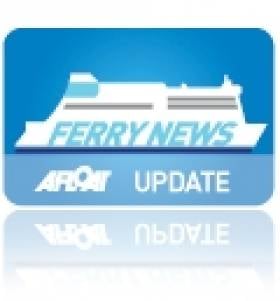Displaying items by tag: Superfast Ferries
#SuperfastCharter – The pair of 'Superfast' ferries serving Stena Line's Belfast-Cairnryan route have been extended on a charter contract with Tallink until August 2019.
The extended period is a further development of the company's freight business on the North Channel route between Northern Ireland and Scotland. The route offers up to 12 sailings daily with the Superfast vessels, Stena Superfast VII and Stena Superfast VIII on the 2 hour 15 minute crossing.
Since the inaugural sailings of the Superfast ferries in November 2011, they have boosted capacity to the route, service reliability and a steady increase in freight volumes. On board, freight drivers benefit from dedicated facilities of a lounge with a restaurant. The Superfast lounges feature first class style reclining seats.
According to Stena Line Freight, they continue to broaden business by offering new services, for example, a fuel-facility in Loch Ryan Port, Cairnryan and with Add Blue now available in addition to diesel.
The terminals at Belfast Harbour Freight hub are in close proximity for hauliers by combining operations with Stena Line's other routes to Liverpool (Birkenhead) and Heysham.
As previously reported on Afloat.ie, the freight-ferry Stena Hibernia on Belfast to Liverpool (Birkenhead) is now operating to an adjusted sailing schedule. The route is also served by a pair of passenger ro-pax sisters, Stena Lagan and Stena Mersey.
Stena 'Superfast' Ferries to Get the Nordic Spa Treatment
Apart from the novelty factor of this on board feature the 30,285grt vessels will also the largest ever deployed on any North Channel route. In addition the region will see the opening of the new £80m ferryport of Loch Ryan Port, located close to rivals, P&O (Irish Sea) at their terminal in Cairnryan.
Stena's decision to relocate to Loch Ryan Port which is only eight miles away from its existing Scottish terminal in Stranraer on the shores of Loch Ryan is to reduce passage times, fuel costs and road travel times. The closure of this port will also see the end of HSS fast-craft sailings served by HSS Stena Voyager and conventional vessels Stena Caledonia and Stena Navigator.
The Superfast sisters are on charter for two-years, where they will operated the new 2 hour 15 minute route which is due to be launched on 21 November. They will make 12 crossings per day and each of the ten-deck ships can carry up to 1200 passengers, 660 cars or 110 freight units.
Originally the pair, built in 2001 at the Howaldtswerde Deutsche Werft AG, Kiel for Attica Enterprises, were used by Superfast Ferries on their German (Rostock-Hanko) Finnish route. In 2006 they were sold to Tallink, where they operated on other Scandinavian services.
Superfast Sisterships for Stena's Northern Route
Stena will lease the ferries for a three year period from Tallink, the Baltic Sea based shipping group. (Click here for photo of Superfast VIII in ice-flow waters). The charter arrangement includes an option to extend for a further year.
The distance between the new ferry terminal named the 'Loch Ryan Port' at Old House Point (which is just north of Cairnryan) is approx. 8kms apart from Stranraer taking the coastal (A77) road along the Loch that leads onto to Glasgow. At Cairnryan, rivals P&O (Irish Sea) who along with predecessing operators have run services on the route to Larne for several decades.
With a speed of 27-knots, passage times on the new Stena Belfast-Cairnryan route will take 2 hours 15 minutes, this compares to the existing time of 2 hours 50 minutes from Stranraer by conventional ferry and 2 hours taken by the HSS fast-ferry.
As a consequence of Stena operating from Loch Ryan Port, passage times by the Superfast sisters will be reduced by 35 minutes as the Belfast terminal was also relocated in recent years. Though despite the relocated ferry terminals, the Superfast sisters scheduled 2 hours 15 minutes sailings from the new port will be slightly longer compared to the HSS Stena Voyager's 2 hour sailing time from Stranraer.
Also serving the Belfast Stranraer route are the conventional ferries, Stena Caledonia (formerly Sealink's St. David built at Harland & Wolff) and Stena Navigator, that served SeaFrance on Dover-Calais sailings as SeaFrance Manet. When the Superfast sisters replace the HSS Stena Explorer and the conventional ferries, perhaps there will be a new a role for the two vessels in replacing expensive to run fast-craft operated elsewhere.
In the meantime the Superfast pair will maintain running on Tallink's 26-hour Helsinki-Rostock until mid-August. The 2001 German will then undergo an extensive refit of passenger facilities and a new freight-only deck will be incorporated to cater for haulage operators increasing use of higher vehicles and double-deck freight units.
The 'Superfast' vessel naming theme derives from the original owners, Greek operator Superfast Ferries, which sold their Scandinavian operations to Tallink in 2006.


























































